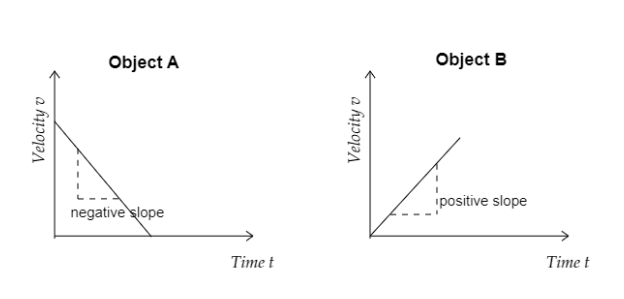
What is called negative acceleration?
Answer
564k+ views
Hint:Acceleration refers to the rate at which the velocity of a body changes over time. Negative acceleration will then refer to the rate of change in the velocity of the body but as it carries a negative sign, it will be in the opposite direction.
Complete step by step answer.
Step 1: Express the relation for the negative acceleration of a body and mention the significance of the negative sign.
The acceleration of a body essentially describes how fast the velocity of the body changes with time. The average acceleration can be expressed as $a = \dfrac{{{v_2} - {v_1}}}{{{t_2} - {t_1}}} = \dfrac{{\Delta v}}{{\Delta t}}$ where ${v_1}$ , ${v_2}$ are the instantaneous velocity of the body at times ${t_1}$ , ${t_2}$ respectively.
Now the instantaneous acceleration of the body is expressed as $a = \mathop {\lim }\limits_{\Delta t \to 0} \dfrac{{\Delta v}}{{\Delta t}} = \dfrac{{dv}}{{dt}}$ .
A body having a negative acceleration is said to be decelerating. Hence the negative acceleration of the body can be called the deceleration of the body.
The instantaneous deceleration of the body can be expressed as $a = - \dfrac{{dv}}{{dt}}$ ---------- (1).
Since acceleration is a vector, the negative sign in equation (1) indicates that the acceleration of the body has a direction opposite to the velocity of the body.
If we were to plot a graph between the velocities of a body at the different instants of time, then the slope of the curve will be the acceleration of the body. So a body with negative acceleration will have a negative slope.
The graphs between the velocity and time of two objects A and B are given below.

From the above figure, the graph of object A has a negative slope and so object A will be decelerating. Object B has a positive slope and so it will be accelerating. The negative slope of object A corresponds to a decrease in its velocity whereas the positive slope of object B corresponds to an increase in its velocity.
Note:The negative acceleration is also referred to as retardation and the body is said to be retarding. If object A was moving in a negative direction and speeding up, then the acceleration of the body would have been in the same direction as that of its velocity. But as the body is moving in the negative direction, its velocity will be negative and so acceleration will also be negative.
Complete step by step answer.
Step 1: Express the relation for the negative acceleration of a body and mention the significance of the negative sign.
The acceleration of a body essentially describes how fast the velocity of the body changes with time. The average acceleration can be expressed as $a = \dfrac{{{v_2} - {v_1}}}{{{t_2} - {t_1}}} = \dfrac{{\Delta v}}{{\Delta t}}$ where ${v_1}$ , ${v_2}$ are the instantaneous velocity of the body at times ${t_1}$ , ${t_2}$ respectively.
Now the instantaneous acceleration of the body is expressed as $a = \mathop {\lim }\limits_{\Delta t \to 0} \dfrac{{\Delta v}}{{\Delta t}} = \dfrac{{dv}}{{dt}}$ .
A body having a negative acceleration is said to be decelerating. Hence the negative acceleration of the body can be called the deceleration of the body.
The instantaneous deceleration of the body can be expressed as $a = - \dfrac{{dv}}{{dt}}$ ---------- (1).
Since acceleration is a vector, the negative sign in equation (1) indicates that the acceleration of the body has a direction opposite to the velocity of the body.
If we were to plot a graph between the velocities of a body at the different instants of time, then the slope of the curve will be the acceleration of the body. So a body with negative acceleration will have a negative slope.
The graphs between the velocity and time of two objects A and B are given below.

From the above figure, the graph of object A has a negative slope and so object A will be decelerating. Object B has a positive slope and so it will be accelerating. The negative slope of object A corresponds to a decrease in its velocity whereas the positive slope of object B corresponds to an increase in its velocity.
Note:The negative acceleration is also referred to as retardation and the body is said to be retarding. If object A was moving in a negative direction and speeding up, then the acceleration of the body would have been in the same direction as that of its velocity. But as the body is moving in the negative direction, its velocity will be negative and so acceleration will also be negative.
Recently Updated Pages
Why are manures considered better than fertilizers class 11 biology CBSE

Find the coordinates of the midpoint of the line segment class 11 maths CBSE

Distinguish between static friction limiting friction class 11 physics CBSE

The Chairman of the constituent Assembly was A Jawaharlal class 11 social science CBSE

The first National Commission on Labour NCL submitted class 11 social science CBSE

Number of all subshell of n + l 7 is A 4 B 5 C 6 D class 11 chemistry CBSE

Trending doubts
What is meant by exothermic and endothermic reactions class 11 chemistry CBSE

10 examples of friction in our daily life

One Metric ton is equal to kg A 10000 B 1000 C 100 class 11 physics CBSE

1 Quintal is equal to a 110 kg b 10 kg c 100kg d 1000 class 11 physics CBSE

Difference Between Prokaryotic Cells and Eukaryotic Cells

What are Quantum numbers Explain the quantum number class 11 chemistry CBSE




